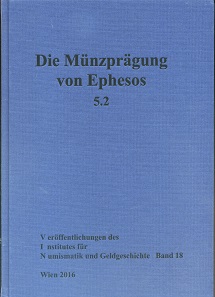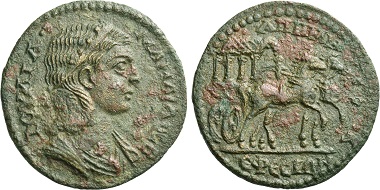by Ursula Kampmann
translated by Annika Backe
May 11, 2017 – Let’s face it. Stefan Karwiese frequently expects the average numismatist to put up with a surprising variant of the familiar. The illustrations of his first volume of the coinage of Ephesus, published in 1995, became legendary. The – rather poor – illustrations of the electrum coins in different scales had been reduced by another 10% – for “typographical reasons”. RPC 3,1 passes judgement on his 2012 first volume MvE 5,1, with a catalog and illustrations, that it followed “a kind of alphabetical order” which “disguises the development of the coinage within a reign”. On the new book, the publisher also comments: “The publisher points out that the layout of the present volume is in line with the author’s expressed wishes”. This could explain the subsequent pasting of the imprint on the fourth page.
Stefan Karwiese, Die Münzprägung von Ephesos (MvE) 5. Corpus und Aufbau der römerzeitlichen Stadtprägung. 2. Statistiken, Metrologie und Kommentare. Veröffentlichungen des Instituts für Numismatik und Geldgeschichte 18. Österreichische Forschungsgesellschaft für Numismatik, Vienna 2016. 350 pages, color graphics and illustrations, 30.2 x 21.6 cm, hardcover. ISBN: 978-3-9501987-7-5. 48 euros plus postage.
So, what has the new book to offer? Firstly, it is arranged in a strict chronological order – emperor after emperor. A statistic is being established for every ruler, counting all coins recorded, their obverse and reverse dies, the number of mint masters attested and the number of coin types. A diagram then lists the die combinations. It is a complex diagram that takes some time to understand. Unfortunately, the reviewer couldn’t spend the time necessary for the diagram to reveal its message. Next are extended treatises on metrology, also equipped with complex tables and full-length explanations.
Lastly, there is the commentary. It confronts the reader with numerous propositions which aren’t explained any further. These are some examples – all originally in German translated into English (and collected in no longer than two minutes): “The oldest examples of the group are those without names, they will be put at the beginning”; “The staggered heads of the IIIviri show little portrait similarity, not even in the case of Octavian who is most likely to be the first in the row.” (Really? Why not Marc Antony, all the more if, as stated on the next page “the heads of the IIIviri furthermore stand out because of their narrowness: An exception, however, is Vs. 1 (obv. 1; translator’s note) with the front bust recalling M. Antony.” Or this enigmatic statement: “A new variant of the Aurelian dadophoros (LN304), bearing the same legend as that of the priest emperor, with three monumental coins points to the importance of the pannychides in the cult, those nocturnal ceremonies devoted also elsewhere to Dionysus and, in addition, to Artemis.”
It thus takes a lot of academic openness to follow the author in his comments, let alone understand him. The comments span 224 pages, forming the major part of the book.
They are interrupted by finalizing statistics which sum up the statistics according to groups of emperors and attribute the reverse types to the individual rulers.
This is followed by a picture inventory which documents, arranged according to the emperors, ALL obverses and then – classified by theme – all reverses. Well, this “picture inventory” might be of use after all. If you don’t want to browse through the first corpus MvE 5,1, you can rather easily find the relevant reverse of the coin you are looking for and assign a number.
Julia Mamaea. Ephesus. Bronze. BMC 328. SNG von Aulock 1911. SNG Cop. cf. 468 (obv), 471 (rev). Karwiese not cited. From NAC sale 100 (2017), No. 1226.
Therefore, the bronze coin of Julia Mamaea that has just been published in the latest NAC catalog – not identified according to Karwiese for obvious reasons – should be described as ‘Karwiese MvE 5.2 Iul. Mamaea Vs 1 / Rs 806’. Due to the varying quality of the photos, it was only possible to identify the reverse after checking with the table that lists the two reverse dies with the depiction of the apame that have been combined with the portrait of Empress Julia Mamaea. By the way, if you would like to know why the author has used “apame” instead of cult chariot as a term much more familiar to the average numismatist…., no idea.
More tables follow. The sense or nonsense of these is open to dispute. As is the sense or nonsense of this volume. It might be ingenious, but sadly it’s too much to ask from the reviewer, being an average numismatist, to acknowledge this ingenuity. She adheres to the old-school idea that Provincial numismatics should help reconstruct the lost local histories of all these cities, and understand their cults and their political structure. Such issues are not of interest to the author. A case in point is the “knucklebone player” who has received wide response in the academic literature in the context of a discussion of the oracle by lot. Such an oracle is nowhere mentioned by Karwiese – strikingly enough, Karwiese’s book doesn’t contain any register of the bibliography he had accessed. Yet you do learn when this “knucklebone player” was depicted, and on how many dies. And this leads to the crucial question: Who wants to know?
You can order the new book at the Institut für Numismatik und Geldgeschichte.
The first volume of this series is still available and can be ordered here.
Another volume is in preparation. It is likely to provide the missing historico-cultural background.






